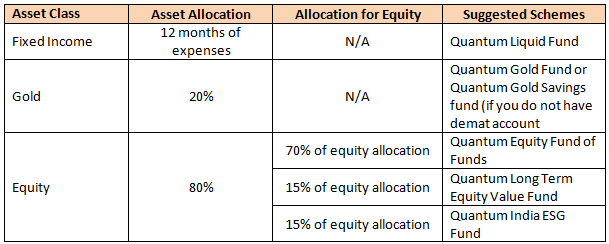12-20-80 Asset Allocation Strategy and how investors can benefit from it

Asset allocation is one of the most important aspects of financial planning. The purpose of asset allocation is to balance risk and return in your portfolio. Quantum Mutual Fund’s 12 – 20 – 80* asset allocation strategy is aimed at building a balanced diversified portfolio which invests across different asset classes. The long term objective of this asset allocation strategy is wealth creation but in the short term, this strategy can reduce downside volatility and provide stability.
What is Quantum MF’s 12 – 20 – 80 strategy?
- Liquid fund: Invest savings equal to 12 months of expenses in a liquid fund. The liquid fund investment will be an emergency fund which help you meet unforeseen situations e.g. sudden loss of income, unexpected large expenditure etc. You need high degree of safety in this investment.
- Gold: Invest 20% of your long term funds in gold. Gold Exchange Traded Funds (ETFs) are more efficient investment options compared to physical gold (e.g. jewellery, bars, coins etc). There are no storage costs (bank locker charges), risk of impurities, risk of theft etc in gold ETFs. Gold is a very important asset class in diversifying portfolio risks. Historical data shows that gold is counter-cyclical to equities i.e. gold outperforms when equity underperforms and vice versa. Gold is also a hedge against inflation in the long term.
- Equity: Invest 80% of your long term funds in equity. Historical data shows that equity, as an asset class, can outperform other asset classes over long investment horizons. Your equity portfolio should be diversified across industry sectors and market capitalization segments, so that you have low unsystematic risks in your portfolio.
Quantum MF’s 12 – 20 – 80 strategy calls for investing in equity funds of different market cap segments, investment styles and strategies to build a truly diversified portfolio.
Model portfolio with Quantum MF’s 12 – 20 – 80 strategy

How has this model portfolio performed?
We have back-tested the performance of this portfolio (only the equity and gold portion) from 1st April 2017 (inception date of Quantum Equity FOF) to 30th November 2021. Since Quantum India ESG Fund was launched in 2019, we have used its benchmark Nifty 100 ESG TRI in our back-testing analysis. Investors should note that Quantum India ESG Fund has outperformed the Nifty 100 ESG TRI since its inception in 2019. So one can expect the portfolio with Quantum India ESG Fund to perform even better than what the back-testing analysis may suggest.
The table below shows the growth in value of Rs 1 lakh investment in the model portfolio from 1st April 2017 to 30th November 2021. During this period, we experienced different market conditions e.g. bear market, bull market, flat market. The annualized return (CAGR) of the model portfolio over the last 4.5 years (ending 30th November 2021) was 12.7%. Over the same period Nifty 50 TRI gave 15% CAGR return. Though portfolio return was slightly lower than Nifty, it provided a more stable investment experience, as we will see in the next section.

Notes: 1. NAVs on 01/04/2017. 2 NAVs on 30/11/2021. 3. Nifty 100 ESG TRI is the benchmark index Quantum India ESG Fund and has been used as a proxy for the scheme for purposes of this analysis. 4. Market value of the portfolio as on 30th November 2021. Regular plans of the mutual fund schemes of Quantum Equity FOF and Quantum Long Term Equity Value Fund have been considered for analysis. Data source: Advisorkhoj Research, National Stock Exchange. Disclaimer: Past performance may or may not be sustained in the future.
Limited downside risk
We simulated the drawdown of Rs 1 lakh investment in the portfolio compared to Nifty 50 TRI from the pre COVID peak (17th January 2020) to the COVID market crash bottom (23rd March 2020). During this period Nifty 50 TRI fell by 38%, while the model portfolio fell by 28% (see the table below). You can see that the asset allocation strategy limited the downside risk and provided stability in highly volatile market.

Notes: 1. Market value of the portfolio as on 30th November 2021. Regular plans of the mutual fund schemes of Quantum Equity FOF, Quantum Long Term Equity Value Fund and Quantum India ESG Fund have been considered for analysis. Data source: Advisorkhoj Research, National Stock Exchange. Disclaimer: Past performance may or may not be sustained in the future.
Portfolio schemes
- Quantum Liquid Fund: Invests only in AAA rated papers issued by Government authorities. High liquidity and low credit risk (safety).
- Quantum Gold Fund: Backed by pure 24 karat physical gold (independent testing of gold purity). Liquidity through stock exchanges. You need a demat account to invest in this fund. If you do not have a demat account, then you can invest in Quantum Gold Savings Fund.
- Quantum Equity Fund of Funds: Invests in 5 – 10 equity funds based on Quantum MF’s in-house research and selection criteria. The FOF aims to build a portfolio of funds diversified across different market cap segments (e.g. large cap, midcap), fund manager investment styles (e.g. growth, value) and strategies (e.g. blue chip, flexicap etc).
- Quantum Long Term Equity Value Fund: Follows the philosophy of value investing. Value investors aim to identify and invest in quality stocks that are currently priced at deep discounts to their intrinsic valuation. The fund aims to deliver long term risk adjusted returns, even though it may underperform in the short term.
- Quantum India ESG Fund: Selects stocks based on ESG principles i.e. environmental, social and governance principles. Stocks scoring high on sustainability (ESG) parameters in the long term have the potential to outperform and can be more resilient in market / economic shocks (as was seen in the 2020 correction).
Benefits of Quantum MF 12-20-80 asset allocation strategy
- Long term risk adjusted returns and potential wealth creation. Investors should have long investment horizons.
- Invest in multiple asset classes e.g. fixed income, gold, equity.
- Provide relative stability in volatile markets.
- Invest in a diversified portfolio of equity schemes across different market cap segments, styles and strategies, without having to analyze and research large number of funds
- Invest in companies which have high quality management; the AMC’s stock selection process will screen out companies where management quality and actions are questionable. Retail investors may find it difficult to identify such companies.
- Build an emergency fund for unforeseen exigencies.
Investors should discuss with their financial advisors if the 12-20-80 strategy is suitable for their risk appetites and investment needs.
Mutual Fund Investments are subject to market risk, read all scheme related documents carefully.
Queries
-
What is the benefit of mutual fund STP
Aug 29, 2019
-
How much to invest to meet target amount of Rs 2 Crores
Aug 26, 2019
-
Can I achieve my financial goals with my current mutual fund investments
Aug 24, 2019
-
Can you tell me return of various indices
Aug 19, 2019
-
What would be the post tax return on different investments
Aug 18, 2019
-
Which Principal Mutual Fund scheme will be suitable for my retirement corpus
Aug 16, 2019
-
What is the minimum holding period for availing NCD interest
Aug 4, 2019
Top Performing Mutual Funds
Recommended Reading
Fund News
-
The Wealth Company Mutual Fund launches The Wealth Company Gold ETF FOF
Jan 9, 2026 by Advisorkhoj Team
-
Mahindra Manulife Mutual Fund launches Mahindra Manulife Innovation Opportunities Fund
Jan 9, 2026 by Advisorkhoj Team
-
Jio BlackRock Mutual Fund launches Jio BlackRock Short Duration Fund
Jan 8, 2026 by Advisorkhoj Team
-
Jio BlackRock Mutual Fund launches Jio BlackRock Low Duration Fund
Jan 8, 2026 by Advisorkhoj Team
-
Groww Mutual Fund launches Groww Small Cap Fund
Jan 8, 2026 by Advisorkhoj Team














